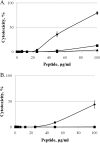In vitro potential of equine DEFA1 and eCATH1 as alternative antimicrobial drugs in rhodococcosis treatment
- PMID: 22232283
- PMCID: PMC3318344
- DOI: 10.1128/AAC.05797-11
In vitro potential of equine DEFA1 and eCATH1 as alternative antimicrobial drugs in rhodococcosis treatment
Abstract
Rhodococcus equi, the causal agent of rhodococcosis, is a severe pathogen of foals but also of immunodeficient humans, causing bronchopneumonia. The pathogen is often found together with Klebsiella pneumoniae or Streptococcus zooepidemicus in foals. Of great concern is the fact that some R. equi strains are already resistant to commonly used antibiotics. In the present study, we evaluated the in vitro potential of two equine antimicrobial peptides (AMPs), eCATH1 and DEFA1, as new drugs against R. equi and its associated pathogens. The peptides led to growth inhibition and death of R. equi and S. zooepidemicus at low micromolar concentrations. Moreover, eCATH1 was able to inhibit growth of K. pneumoniae. Both peptides caused rapid disruption of the R. equi membrane, leading to cell lysis. Interestingly, eCATH1 had a synergic effect together with rifampin. Furthermore, eCATH1 was not cytotoxic against mammalian cells at bacteriolytic concentrations and maintained its high killing activity even at physiological salt concentrations. Our data suggest that equine AMPs, especially eCATH1, may be promising candidates for alternative drugs to control R. equi in mono- and coinfections.
Figures




Similar articles
-
The equine antimicrobial peptide eCATH1 is effective against the facultative intracellular pathogen Rhodococcus equi in mice.Antimicrob Agents Chemother. 2013 Oct;57(10):4615-21. doi: 10.1128/AAC.02044-12. Epub 2013 Jul 1. Antimicrob Agents Chemother. 2013. PMID: 23817377 Free PMC article.
-
Antimicrobial properties of the equine alpha-defensin DEFA1 against bacterial horse pathogens.Vet Immunol Immunopathol. 2009 Jul 15;130(1-2):102-6. doi: 10.1016/j.vetimm.2009.01.005. Epub 2009 Jan 23. Vet Immunol Immunopathol. 2009. PMID: 19211153
-
Antimicrobial susceptibility patterns of Rhodococcus equi from necropsied foals with rhodococcosis.Vet Microbiol. 2020 Mar;242:108568. doi: 10.1016/j.vetmic.2019.108568. Epub 2020 Jan 7. Vet Microbiol. 2020. PMID: 32122582
-
Treatment of Infections Caused by Rhodococcus equi.Vet Clin North Am Equine Pract. 2017 Apr;33(1):67-85. doi: 10.1016/j.cveq.2016.11.002. Epub 2017 Feb 1. Vet Clin North Am Equine Pract. 2017. PMID: 28161038 Review.
-
Rhodococcus Equi: Challenges to Treat Infections and to Mitigate Antimicrobial Resistance.J Equine Vet Sci. 2023 Aug;127:104845. doi: 10.1016/j.jevs.2023.104845. Epub 2023 Jun 7. J Equine Vet Sci. 2023. PMID: 37295760 Review.
Cited by
-
A Simplified Derivative of Human Defensin 5 with Potent and Efficient Activity against Multidrug-Resistant Acinetobacter baumannii.Antimicrob Agents Chemother. 2018 Jan 25;62(2):e01504-17. doi: 10.1128/AAC.01504-17. Print 2018 Feb. Antimicrob Agents Chemother. 2018. PMID: 29158275 Free PMC article.
-
Cathelicidins from the bullfrog Rana catesbeiana provides novel template for peptide antibiotic design.PLoS One. 2014 Mar 27;9(3):e93216. doi: 10.1371/journal.pone.0093216. eCollection 2014. PLoS One. 2014. PMID: 24675879 Free PMC article.
-
Whole Genome Sequencing Provides New Insights Into the Genetic Diversity and Coat Color of Asiatic Wild Ass and Its Hybrids.Front Genet. 2022 May 12;13:818420. doi: 10.3389/fgene.2022.818420. eCollection 2022. Front Genet. 2022. PMID: 35646088 Free PMC article.
-
Killing of Trypanozoon Parasites by the Equine Cathelicidin eCATH1.Antimicrob Agents Chemother. 2016 Apr 22;60(5):2610-9. doi: 10.1128/AAC.01127-15. Print 2016 May. Antimicrob Agents Chemother. 2016. PMID: 26824936 Free PMC article.
-
The equine antimicrobial peptide eCATH1 is effective against the facultative intracellular pathogen Rhodococcus equi in mice.Antimicrob Agents Chemother. 2013 Oct;57(10):4615-21. doi: 10.1128/AAC.02044-12. Epub 2013 Jul 1. Antimicrob Agents Chemother. 2013. PMID: 23817377 Free PMC article.
References
-
- . 1992. Synergism testing: broth microdilution checkerboard and broth macrodilution methods. American Society for Microbiology, Washington, DC
-
- Barton MD, Hughes KL. 1980. Corynebacterium equi: a review. 50:60–80
-
- Bell G, Gouyon PH. 2003. Arming the enemy: the evolution of resistance to self-proteins. Microbiology 149:1367–1375 - PubMed
Publication types
MeSH terms
Substances
LinkOut - more resources
Full Text Sources
Medical

